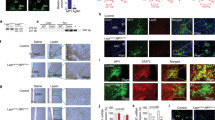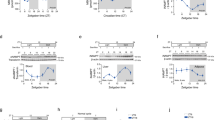Abstract
Background/Objectives:
Stearoyl-CoA desaturase-2 (SCD2) is the main δ9 desaturase expressed in the central nervous system. Because of its potential involvement in controlling whole-body adiposity, we evaluated the expression and function of SCD2 in the hypothalami of mice.
Subjects/Methods:
Male mice of different strains were used in real-time PCR, immunoblot and metabolic experiments. In addition, antisense oligonucleotides and lentiviral vectors were used to reduce and increase the expression of SCD2 in the hypothalamus.
Results:
The level of SCD2 in the hypothalamus is similar to other regions of the central nervous system and is ~10-fold higher than in any other region of the body. In the arcuate nucleus, SCD2 is expressed in proopiomelanocortin and neuropeptide-Y neurons. Upon high fat feeding, the level of hypothalamic SCD2 increases. Inhibition of hypothalamic SCD2 as accomplished by two distinct approaches, an antisense oligonucleotide or a short-hairpin RNA delivered by a lentivirus, resulted in reduced body mass gain mostly due to increased energy expenditure and increased spontaneous activity. Increasing hypothalamic SCD2 by a lentivirus approach resulted in no change in body mass and food intake.
Conclusions:
Thus, SCD2 is highly expressed in the hypothalami of rodents and its knockdown reduces body mass due to increased whole-body energy expenditure.
This is a preview of subscription content, access via your institution
Access options
Subscribe to this journal
Receive 12 print issues and online access
$259.00 per year
only $21.58 per issue
Buy this article
- Purchase on Springer Link
- Instant access to full article PDF
Prices may be subject to local taxes which are calculated during checkout






Similar content being viewed by others
References
Moussavi N, Gavino V, Receveur O . Could the quality of dietary fat, and not just its quantity, be related to risk of obesity? Obesity 2008; 16: 7–15.
Goris AH, Westerterp KR . Physical activity, fat intake and body fat. Physiol Behav 2008; 94: 164–168.
Hirosumi J, Tuncman G, Chang L, Gorgun CZ, Uysal KT, Maeda K et al. A central role for JNK in obesity and insulin resistance. Nature 2002; 420: 333–336.
Kim JK, Kim YJ, Fillmore JJ, Chen Y, Moore I, Lee J et al. Prevention of fat-induced insulin resistance by salicylate. J Clin Invest 2001; 108: 437–446.
De Souza CT, Araujo EP, Bordin S, Ashimine R, Zollner RL, Boschero AC et al. Consumption of a fat-rich diet activates a proinflammatory response and induces insulin resistance in the hypothalamus. Endocrinology 2005; 146: 4192–4199.
Zhang X, Zhang G, Zhang H, Karin M, Bai H, Cai D . Hypothalamic IKKbeta/NF-kappaB and ER stress link overnutrition to energy imbalance and obesity. Cell 2008; 135: 61–73.
Milanski M, Degasperi G, Coope A, Morari J, Denis R, Cintra DE et al. Saturated fatty acids produce an inflammatory response predominantly through the activation of TLR4 signaling in hypothalamus: implications for the pathogenesis of obesity. J Neurosci 2009; 29: 359–370.
Benoit SC, Kemp CJ, Elias CF, Abplanalp W, Herman JP, Migrenne S et al. Palmitic acid mediates hypothalamic insulin resistance by altering PKC-theta subcellular localization in rodents. J Clin Invest 2009; 119: 2577–2589.
Fisher LM . DNA supercoiling and gene expression. Nature 1984; 307: 686–687.
Fowler KH, Chapkin RS, McMurray DN . Effects of purified dietary n-3 ethyl esters on murine T lymphocyte function. J Immunol 1993; 151: 5186–5197.
Cintra DE, Ropelle ER, Moraes JC, Pauli JR, Morari J, Souza CT et al. Unsaturated fatty acids revert diet-induced hypothalamic inflammation in obesity. PloS One 2012; 7: e30571.
Knoops KT, de Groot LC, Kromhout D, Perrin AE, Moreiras-Varela O, Menotti A et al. Mediterranean diet, lifestyle factors, and 10-year mortality in elderly European men and women: the HALE project. JAMA 2004; 292: 1433–1439.
Estruch R, Ros E, Salas-Salvado J, Covas MI, Corella D, Aros F et al. Primary prevention of cardiovascular disease with a Mediterranean diet. N Engl J Med 2013; 368: 1279–1290.
Bjerregaard P, Mulvad G, Pedersen HS . Cardiovascular risk factors in Inuit of Greenland. Int J Epidemiol 1997; 26: 1182–1190.
Popeijus HE, Saris WH, Mensink RP . Role of stearoyl-CoA desaturases in obesity and the metabolic syndrome. Int J Obes 2008; 32: 1076–1082.
Man WC, Miyazaki M, Chu K, Ntambi JM . Membrane topology of mouse stearoyl-CoA desaturase 1. J Biol Chem 2006; 281: 1251–1260.
Cohen P, Miyazaki M, Socci ND, Hagge-Greenberg A, Liedtke W, Soukas AA et al. Role for stearoyl-CoA desaturase-1 in leptin-mediated weight loss. Science 2002; 297: 240–243.
Sarbassov DD, Sabatini DM . Redox regulation of the nutrient-sensitive raptor-mTOR pathway and complex. J Biol Chem 2005; 280: 39505–39509.
Morari J, Anhe GF, Nascimento LF, de Moura RF, Razolli D, Solon C et al. Fractalkine (CX3CL1) is involved in the early activation of hypothalamic inflammation in experimental obesity. Diabetes 2014; 63: 3770–3784.
Velloso LA, Schwartz MW . Altered hypothalamic function in diet-induced obesity. Int J Obes 2011; 35: 1455–1465.
Morton GJ, Cummings DE, Baskin DG, Barsh GS, Schwartz MW . Central nervous system control of food intake and body weight. Nature 2006; 443: 289–295.
Romanatto T, Roman EA, Arruda AP, Denis RG, Solon C, Milanski M et al. Deletion of tumor necrosis factor-alpha receptor 1 (TNFR1) protects against diet-induced obesity by means of increased thermogenesis. J Biol Chem 2009; 284: 36213–36222.
Thaler JP, Yi CX, Schur EA, Guyenet SJ, Hwang BH, Dietrich MO et al. Obesity is associated with hypothalamic injury in rodents and humans. J Clin Invest 2012; 122: 153–162.
Belgardt BF, Mauer J, Wunderlich FT, Ernst MB, Pal M, Spohn G et al. Hypothalamic and pituitary c-Jun N-terminal kinase 1 signaling coordinately regulates glucose metabolism. Proc Natl Acad Sci USA 2010; 107: 6028–6033.
van de Sande-Lee S, Pereira FR, Cintra DE, Fernandes PT, Cardoso AR, Garlipp CR et al. Partial reversibility of hypothalamic dysfunction and changes in brain activity after body mass reduction in obese subjects. Diabetes 2011; 60: 1699–1704.
Oh DY, Talukdar S, Bae EJ, Imamura T, Morinaga H, Fan W et al. GPR120 is an omega-3 fatty acid receptor mediating potent anti-inflammatory and insulin-sensitizing effects. Cell 2010; 142: 687–698.
Pan DA, Hulbert AJ, Storlien LH . Dietary fats, membrane phospholipids and obesity. J Nutr 1994; 124: 1555–1565.
Nakamura MT, Nara TY . Structure, function, and dietary regulation of delta6, delta5, and delta9 desaturases. Annu Rev Nutr 2004; 24: 345–376.
Jones PD, Holloway PW, Peluffo RO, Wakil SJ . A requirement for lipids by the microsomal stearyl coenzyme A desaturase. J Biol Chem 1969; 244: 744–754.
Sampath H, Miyazaki M, Dobrzyn A, Ntambi JM . Stearoyl-CoA desaturase-1 mediates the pro-lipogenic effects of dietary saturated fat. J Biol Chem 2007; 282: 2483–2493.
Sampath H, Ntambi JM . The role of stearoyl-CoA desaturase in obesity, insulin resistance, and inflammation. Ann N Y Acad Sci 2011; 1243: 47–53.
Enoch HG, Catala A, Strittmatter P . Mechanism of rat liver microsomal stearyl-CoA desaturase. Studies of the substrate specificity, enzyme-substrate interactions, and the function of lipid. J Biol Chem 1976; 251: 5095–5103.
Smith SB, Mersmann HJ, Smith EO, Britain KG . Stearoyl-coenzyme A desaturase gene expression during growth in adipose tissue from obese and crossbred pigs. J Anim Sci 1999; 77: 1710–1716.
Ntambi JM, Miyazaki M, Stoehr JP, Lan H, Kendziorski CM, Yandell BS et al. Loss of stearoyl-CoA desaturase-1 function protects mice against adiposity. Proc Natl Acad Sci USA 2002; 99: 11482–11486.
Kaestner KH, Ntambi JM, Kelly TJ Jr., Lane MD . Differentiation-induced gene expression in 3T3-L1 preadipocytes. A second differentially expressed gene encoding stearoyl-CoA desaturase. J Biol Chem 1989; 264: 14755–14761.
Garbay B, Bauxis-Lagrave S, Boiron-Sargueil F, Elson G, Cassagne C . Acetyl-CoA carboxylase gene expression in the developing mouse brain. Comparison with other genes involved in lipid biosynthesis. Brain Res Dev Brain Res 1997; 98: 197–203.
Zhang S, Yang Y, Shi Y . Characterization of human SCD2, an oligomeric desaturase with improved stability and enzyme activity by cross-linking in intact cells. Biochem J 2005; 388 (Pt 1): 135–142.
Button EB, Mitchell AS, Domingos MM, Chung JH, Bradley RM, Hashemi A et al. Microglial cell activation increases saturated and decreases monounsaturated fatty acid content, but both lipid species are proinflammatory. Lipids 2014; 49: 305–316.
Elias CF, Aschkenasi C, Lee C, Kelly J, Ahima RS, Bjorbaek C et al. Leptin differentially regulates NPY and POMC neurons projecting to the lateral hypothalamic area. Neuron 1999; 23: 775–786.
van den Top M, Lee K, Whyment AD, Blanks AM, Spanswick D . Orexigen-sensitive NPY/AgRP pacemaker neurons in the hypothalamic arcuate nucleus. Nat Neurosci 2004; 7: 493–494.
Bates SH, Stearns WH, Dundon TA, Schubert M, Tso AW, Wang Y et al. STAT3 signalling is required for leptin regulation of energy balance but not reproduction. Nature 2003; 421: 856–859.
Bouret SG, Bates SH, Chen S, Myers MG Jr, Simerly RB . Distinct roles for specific leptin receptor signals in the development of hypothalamic feeding circuits. J Neurosci 2012; 32: 1244–1252.
Tabor DE, Kim JB, Spiegelman BM, Edwards PA . Identification of conserved cis-elements and transcription factors required for sterol-regulated transcription of stearoyl-CoA desaturase 1 and 2. J Biol Chem 1999; 274: 20603–20610.
Miyazaki M, Dobrzyn A, Elias PM, Ntambi JM . Stearoyl-CoA desaturase-2 gene expression is required for lipid synthesis during early skin and liver development. Proc Natl Acad Sci USA 2005; 102: 12501–12506.
Pereira-da-Silva M, Torsoni MA, Nourani HV, Augusto VD, Souza CT, Gasparetti AL et al. Hypothalamic melanin-concentrating hormone is induced by cold exposure and participates in the control of energy expenditure in rats. Endocrinology 2003; 144: 4831–4840.
Acknowledgements
We thank Dr E. Roman, Mr J. G. Ferraz and Mr M. Cruz, from the University of Campinas, for technical assistance. The support for the study was provided by Sao Paulo Research Foundation and Conselho Nacional de Desenvolvimento Cientifico e Tecnologico. The Laboratory of Cell Signaling belongs to the Obesity and Comorbidities Research Center and National Institute of Science and Technology—Diabetes and Obesity.
Author information
Authors and Affiliations
Corresponding author
Ethics declarations
Competing interests
The authors declare no conflict of interest.
Rights and permissions
About this article
Cite this article
de Moura, R., Nascimento, L., Ignacio-Souza, L. et al. Hypothalamic stearoyl-CoA desaturase-2 (SCD2) controls whole-body energy expenditure. Int J Obes 40, 471–478 (2016). https://doi.org/10.1038/ijo.2015.188
Received:
Revised:
Accepted:
Published:
Issue Date:
DOI: https://doi.org/10.1038/ijo.2015.188



